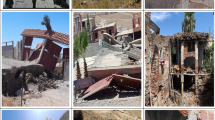Abstract
This paper presents a promising approach to modeling the building resistance in the seismic rehabilitation process. The damage index model (DIM) can be interactively utilized into the Geographical Information Systems (GIS) in order to compute parameters and to analyze data for a quality management purpose. It can perform an easy accessibility of the data to evaluate buildings for earthquake mitigation and preparedness. This research article intended to introduce a software program by using an integration system to design and to dissect the data for evaluating a building resistance against earthquakes. This paper promises a new integrated system for rapid evaluation of buildings, further a city planning by combination of GIS, civil engineering and industrial engineering upon the Federal Emergency Management Agency (FEMA) accompanied by seismic data, structure, parcel, material type, foundation, ceiling, wall, floor, the interior and the exterior. This software has been programmed based on the Damage Index (DI) algorithm that was developed by Pirasteh et al. (Int J Geoinformatics 5(4): 34–41, 2009). Later, based on the proposed algorithm or model the essential parameters have been adopted in Matrix laboratory (MATLAB) environment to yield a new software program for the meliorating earthquake mitigation and preparedness processes. This software program can identify vulnerability of the buildings ranking from 1 to 100. In addition, this paper recommends establishing a scientific procedure in determining the vulnerability of the buildings for earthquake preparedness within a GIS environment. However, this software program can amend in detecting weak structures for rehabilitation.




Similar content being viewed by others
References
Ali SA, Pirasteh S (2004) Geological application of Landsat ETM for mapping structural geology and interpretation: aided by remote sensing and GIS. Int J Remote Sens 25(21):4715–4727
Alam M, Mahmoodzadeh A, Pirasteh S (2009) A method for rapid evaluation of masonry buildings against earthquakes. Int Disaster Adv J 2(3):15–23
Ambrasys NN, Simpson KA, Bommer JJ (1996) Prediction of horizontal response spectra in Europe, earthquake eng. Strua Dyn 25:371–400
Barzangi M (1989) Continental collision zones: Sciesmotectonics and crustal structure. In: James DE (ed) In the encyclopedia of solid earth geophysics. Van nostrand, Rienold, New York, pp 58–75
Berberian M (1994) Natural hazards and the first earthquake catalog of Iran. Int Inst Earthq Eng Seismol 1:266–70
Berberian (1995) The first seismicity catalogue and the natural phenomenon of Iran, first edition; natural hazards prior to twentieth century, (IIEES), pp.17
Cavallaro A, Ferraro A, Grasso S, Maugeri M (2012) Topographic effects of the Monte Po hill in Catania (Italy). Soil Dyn Earthq Eng 43(2012):97–113. doi:10.1016/j.soildyn.2012.07.022, ISSN: 0267–7261
Erdik M, Şeşetyan K, Demircioğlu MB, Hancılar U, Zülfikar C (2011) Rapid earthquake loss assessment after damaging earthquakes. Soil Dyn Earthq Eng 31:247–66
Farrokhnia A, Pirasteh S, Pradhan B, Pourkermani M, Arian M (2011) A recent scenario of mass wasting and its impact on the transportation in Alborz Mountains, Iran: contribution from Geo information technology. Arab Geosci J 4:1337–1349. doi:10.1007/s12517-010-0238-7
Grasso S, Maugeri M (2005) Vulnerability of physical environment of the city of Catania using GIS technique. Adv Earthq Eng 14:155–175
Grasso S, Maugeri M (2009) The seismic microzonation of the city of Catania (Italy) for the maximum expected scenario earthquake of January 11, 1693. Soil Dyn Earthq Eng 29:953–962
Grasso S, Maugeri M (2012) The seismic microzonation of the city of Catania (Italy) for the Etna Scenario Earthquake (M = 6.2) of 20 February 1818. Earthq Spectra (28) 2:573–594
Katsanos EI, Sextos AG, Manolis GD (2010) Selection of earthquake ground motion records: a state-of-the-art review from a structural engineering perspective. Soil Dyn Earthq Eng (30) 4:157–169
Kijko A, Sellevoll MA (1992) Estimate of earthquake hazard parameters from incomplete data files, part ii, incorporation of magnitude heterogeneity. Bull Seismol Soc Am 82:120–134
Maiti K (2001) Bhuj Earthquake Mapping Surface Features Using Remote Sensing Data., M.Tech Dissertation submitted to Department of Earth Sciences. University of Roorkee, Roorkee, p 185
McClusky (2000) GPS constraints on plate kinematics and dynamics in the eastern Mediterranean and Caucasus. J Geophys Res 105:5695–719
Monaco P, Santucci de Magistris F, Grasso S, Marchetti S, Maugeri M, Totani G (2011) Analysis of the liquefaction phenomena in the village of Vittorito (L’Aquila), bulletin earthquake. Eng 9:231–261
Motlaq SK, Pirasteh S, Norozi OA, Pradhan B, Mahmoodzadeh A (2011) Sinkholes mapping using gis: vulnarebility and risk assessment emphasis on development areas. Int Geoinformatics Res Dev J 2(2):49–61
Pirasteh S, Li J, Mollaee S (2014) satellite-based detection of compounding tectonic activities effecting on column of ozone and thermal infrared precursor to earthquake occurrence. Disaster Adv J 7(12):32–40
Pirasteh S, Mahmoodzadeh A, Alam M (2008) Integration of Geo information Technology and Survey Analysis for Development in Mitigation Study against Earthquake: A Case Study for Esfahan Iran, Disaster Adv J, 1(2): 20-26
Pirasteh S, Mahmoodzadeh A, Nikouravan B, Alam M, Asghar RSM (2009) Probabilistic methods and study earthquakes aided by geoinformatics. Int J Geoinformatics 5(4):34–41
Sadra K, Masakatsu M, Hassanzadeh R, Amiraslanzadeh R, Kamel B (2014) A GIS-based seismic hazard, building vulnerability and human loss assessment for the earthquake scenario in Tabriz. Soil Dyn Earthq Eng 66:263–280
Saraf AK, Mishra P, Mitra S, Sarma B, Mukhopadhyay DK (2002) Remote sensing and GIS technologies for improvements in geological structures interpretation and mapping (A Technical note). Int J Remote Sens 23(13):2527–2536
Simac MR, Bathurst RJ, Goodrun RA (1991) Design and analysis of three reinforced soil retaining walls. Proc Geosynth 91 Atlanta GA USA 2:781–789
Zhenzhong Z, Lanmin W (1995) Geological disasters in loess areas during the 1920 Haiyuan earthquake. China Geol J 36:269–274
Author information
Authors and Affiliations
Corresponding author
Additional information
Communicated by: H. A. Babaie
Rights and permissions
About this article
Cite this article
Pirasteh, S., Li, J. & Attarzadeh, I. Implementation of the damage index approach for the rapid evaluation of earthquake resistant buildings. Earth Sci Inform 8, 751–758 (2015). https://doi.org/10.1007/s12145-014-0204-0
Received:
Accepted:
Published:
Issue Date:
DOI: https://doi.org/10.1007/s12145-014-0204-0




